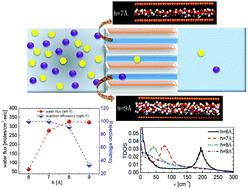Breakdown of continuum model for water transport and desalination through ultrathin graphene nanopores: insights from molecular dynamics simulations†
Abstract
In the quest for identifying a graphene membrane for efficient water desalination, molecular dynamics simulations were performed for the pressure-driven flow of salty water across a multilayer graphene membrane. Water transport through the graphene membranes was tuned as a function of pore size, external pressure, and salt concentration. The results predicted that water permeability through the graphene channel (width of h = 7 Å) is two orders of magnitude higher than that through the conventional thin film membranes. The breaking of continuum assumption in graphene nanopores was captured by the appearance of a layered water structure and plug-like velocity profiles. Furthermore, the fluidity under nano confinement of graphene was examined in terms of shear viscosity, friction coefficient, and slip length, which were found to depend on the separation of the confining graphene walls and the external pressure. Furthermore, the MD results revealed that the macroscopic water flux through the graphene nanopores can be linked to the microscopic diffusion of water. The calculated viscosity and diffusion coefficient under the graphene pores did not follow the Stokes–Einstein relation, indicating the failure of the hydrodynamic theory. The confined state of water in the graphene pores was also explored via the translational density of states (TDOS) and entropy, which displayed a significant change in the translational entropy with change in the pore size and applied pressure and thus revealed the interconnectivity of the structure, dynamics, thermodynamics, and hydrodynamics of water in the graphene nanopores. Such a linking of the microscopic parameters with the macroscopic profiles provides direct evidence to the experiments of pressure-driven flow through the graphene membranes and might be helpful in examining the performance of graphene membranes for the factors that have large implications on their application in the reverse osmosis (RO) process and other biological channels.



 Please wait while we load your content...
Please wait while we load your content...